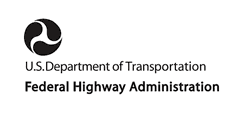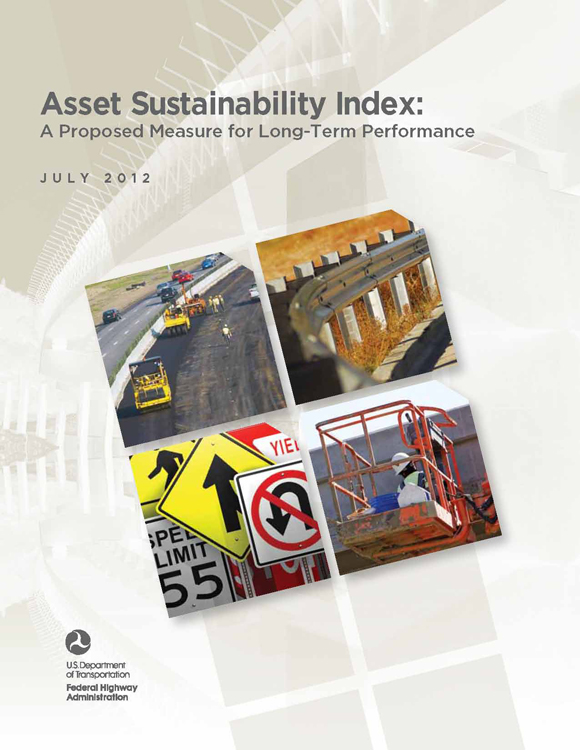Printable version of this case study (.pdf, 4.77 mb)
Transportation Asset Management Case Studies
Comprehensive Transportation Asset Management
Asset Sustainability Index: A Proposed Measure for Long-Term Performance
Table of Contents
List of Figures
- Figure 1: Ratios from Maintenance, Pavements and Bridges combine into the Asset Sustainability Index.
- Figure 2: This illustration depicts how the use of the ASI in a time series represents an important decline in needed infrastructure investment.
- Figure 3: Inputs to the Asset Sustainability Index.
- Figure 4: Pavement Sustainability Ratio and valuation over time.
- Figure 5: The "Sustainability Gap" or investment gap.
- Figure 6: Pavement deterioration curves.
- Figure 7: Guardrail sustainability ratio calculation.
- Figure 8: Long-term investment perspective.
- Figure 9: Combining ratios into an index.
- Figure 10: Kentucky?s Charles Roebling suspension bridge is an example of a unique asset.
- Figure 11: Class I capital investment growth.
- Figure 12: The Balanced Scorecard.
- Figure 13: Sunshine Coast short-term, medium-term and long-term metrics.
- Figure 14: Gold Coast Asset Consumption forecasts.
- Figure 15: Asset values in Bundaberg.
- Figure 16: An idealized example of asset consumption.
- Figure 17: Conditions on Ohio's "priority system".
- Figure 18: Ohio pavement conditions over 30 years.
- Figure 19: Ohio pavement sustainability ratio and gap.
- Figure 20. Construction inflation influenced investment needs.
- Figure 21: Utah pavement conditions over time.
- Figure 22: Utah pavement budget versus condition.
- Figure 23: Backlog of pavement treatments.
- Figure 24: Utah Interstate pavement condition trends.
- Figure 25: NHS conditions and trends.
- Figure 26: Non-NHS condition and trends.
- Figure 27: Budget need for optimal conditions.
- Figure 28: Utah pavement sustainability ratio.
- Figure 29: MnDOT "good" ride quality.
- Figure 30: MnDOT "poor" ride quality index.
- Figure 31: MnDOT remaining service life.
- Figure 32: MnDOT declining program projections.
- Figure 33: MnDOT's declining pavement investment levels.
- Figure 34: Ohio bridge conditions over time.
- Figure 35: General appraisal conditions by district.
- Figure 36: Statewide bridge condition changes.
- Figure 37: Ohio deck condition changes.
- Figure 38: Shifting budgets to address deficiencies.
- Figure 39: Improving conditions over time.
- Figure 40: Shifting bridge allocations over time.
- Figure 41: District 1 bridge funding shifts.
- Figure 42: Heat map of bridge conditions showing shifting conditions over time.
- Figure 43: Statewide "heat map" of bridge conditions and associated sustainability ratio.
- Figure 44: Improvement in MnDOT sufficiency ratings.
- Figure 45: Age profile of MnDOT bridges.
- Figure 46: Bridge conditions and targets over time.
- Figure 47: MnDOT long-term investment trends.
- Figure 48: North Carolina network-wide bridge health conditions.
- Figure 49: Forecasted decline in bridge health at current expenditure levels.
- Figure 50: Targets, Performance, Expenditure and Budgeted Amounts.
- Figure 51: Shoulder Work - Score, Target and Expenditure.
- Figure 52: Pavement striping condition, expenditures.
- Figure 53: Pavement marking targets, expenditures.
- Figure 54: Sign, post conditions expenditures.
- Figure 55: Guardrail performance, expenditure.
- Figure 56: Touch screen menu of deficiencies.
- Figure 57: Map of maintenance deficiencies in one county quadrant.
- Figure 58: A county work plan shows condition, level of effort.
- Figure 59: A county work plan's anticipated level of effort by category of deficiency.
- Figure 60: Ohio guardrail expenditures and conditions.
- Figure 61: General system guardrail conditions, budgets.
- Figure 62: Guardrail Work-Score, Target and Expenditure.
- Figure 63: Shoulder drop off condition, budgets.
- Figure 64: Drop off conditions, expenditures on Priority System.
- Figure 65: Forecasted pavement conditions at current budget levels.
- Figure 66: LOS forecast.
- Figure 67: NC ASI for maintenance categories, expenditures.
- Figure 68: ASI over time.
- Figure 69: Theoretical Pavement Sustainability Ratio and corresponding asset valuation.
List of Tables
- Table 1: Pavement Sustainability Ratio.
- Table 2: Asset value and annual investment needs.
- Table 3: Norfolk Southern RR assets and capital expenditures.
- Table 4: NSC track mileage.
- Table 5: NSC maintenance targets.
- Table 6: NSC rolling stock metrics.
- Table 7: BNSF financial metrics.
- Table 8: BNSF capital investments.
- Table 9: Queensland asset investment indicators.
- Table 10: Sunshine Coast asset investment metrics.
- Table 11: Bundaberg metrics.
- Table 12: Ohio pavement expenditures and outcomes.
- Table 13: Ohio pavement expenditures and outcomes.
- Table 14: Increased investment and achievement of asset goals.
- Table 15: Ohio bridge expenditures, funding gap.
- Table 16: Ohio bridge sustainability ratio components.
- Table 17: Changes in Ohio bridge funding, sustainability ratio.
- Table 18: Bridge condition statistics.
- Table 19. Bridge Sustainability Ratio..
- Table 20: Recurring bridge needs and activities.
- Table 21: Bridge maintenance program categories.
- Table 22: NC bridge conditions, targets.
- Table 23: Recommended expenditure levels.
- Table 24: Maintenance grades.
- Table 25: Shoulder Work - Target, Score, Dollars Spent or Budgeted.
- Table 26: Striping scores, conditions, expenditures.
- Table 27: Pavement markings scores, expenditures.
- Table 28: Sign post scores, expenditures.
- Table 29: Guardrail condition, expenditures.
- Table 30: Guardrail expenditures and conditions.
- Table 31: Shoulder drop off conditions, expenditures.
- Table 32: NC maintenance conditions and targets.
- Table 33: NC Interstate maintenance condition, budget and need.
- Table 34: Forecasted need by category for performance-based activities.
- Table 35: Calculation of a Sustainability Index.
- Table 36: NCDOT bridge maintenance need by category.
- Table 37: Sustainability ratios over time by asset class or activity.
- Table 38: Kansas DOT GASB data.
- Table 39: Kansas highway asset values.
- Table 40: 10 year bridge investment need.
- Table 41: Example of pavement need estimate.
- Table 42: Bridge depreciation costs.
- Table 43: Useful service life.
- Table 44: Example of how sustainability indices can illustrate program needs.
Front Cover Photo: The cover includes photographs of a road paving project, a section of guardrail, a collection of traffic signs and a picture of a worker in a lift truck working on a bridge.
Presented by:

DTFH61-10-C-00036
In accordance
with Contract Number DTFH61-10-C-00036 in response to Broad Area Announcement
"Transportation Changes and Revolutionary Advances for Transportation
Planning"
Presented to:
The Federal Highway Administration
Surface Transportation Environment and Planning Cooperative Research Program
This report submitted by the team of:
Gordon Proctor & Associates, Inc.
StarIsis Corp.
The National Center for Pavement Preservation
Updated: 07/09/2012


